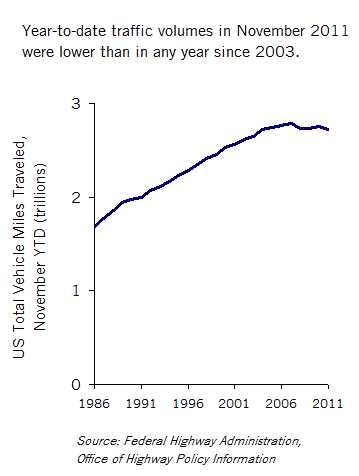The latest traffic figures from the Federal Highway Administration offer a small surprise: through November of 2011, year-to-date vehicle travel in the US hit its lowest level since 2003.
 As you may recall, traffic plummeted in 2008—back when the economy hit the skids, even as gas prices shot through the roof. But most transportation analysts (including me) expected that traffic would resume its upward trajectory as the economy rebounded and population grew. Perhaps that will still happen, someday. But so far, the numbers tell a different story: appetite for car travel in the US appears to have flattened out.
As you may recall, traffic plummeted in 2008—back when the economy hit the skids, even as gas prices shot through the roof. But most transportation analysts (including me) expected that traffic would resume its upward trajectory as the economy rebounded and population grew. Perhaps that will still happen, someday. But so far, the numbers tell a different story: appetite for car travel in the US appears to have flattened out.
For the Northwest, the federal numbers show a mix of trends. In all three states, traffic volumes remain above the trough of late 2008 and 2009. Yet all three states have experienced traffic declines for well over a year. Averaging traffic volumes over the past 12 months, Idaho’s traffic has fallen roughly where it was in mid-2007. In Washington, it’s fallen to mid-2005 levels. And in Oregon, federal numbers show that traffic volumes during 2011 remain about four percent lower than they were back in 2003 (where the federal data trail gets harder to follow).
I make no claims about the accuracy of the federal data series; they don’t always match up with the state figures, for example. But really, when it comes to traffic volumes, there is no such thing as a definitive number. Transportation officials always assemble traffic figures from a somewhat random sampling of data, so vehicle travel estimates always contain some statistical noise. Yet at this point, virtually all of the estimates point in the same direction: traffic volumes just aren’t rising the way that we thought they would just a few years back. In my mind, it’s high time that transportation planners took very careful note of what’s happening, and started factoring recent trends into their thinking about what might happen over the next few decades.








Morgan
thanks for keeping your nose on this topic